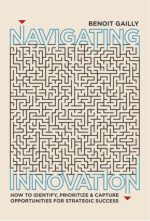NEW: Watch the executive summary
Megatrends such as technology disruptions, international competition and sustainability affect firms across all sectors and industries, creating new competitive and social challenges.
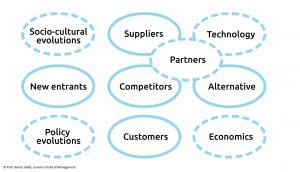
Industries and sectorsare also disrupted by new regulations, new customer needs and new technologies, forcing firms to reconsider the sustainability of their assets and activities.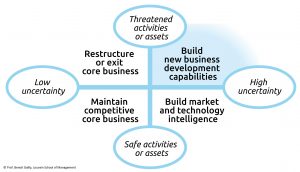
Small and large firms across sectors must place innovation among their strategic priorities if they do not want to suffer the fate of the dinosaurs.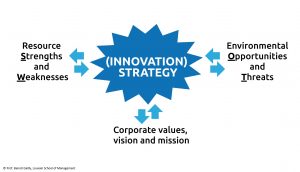
This implies developing dynamic innovation management capabilities to identify, select and capture the right innovation opportunities, in line with the firm’s ecosystem and strategy.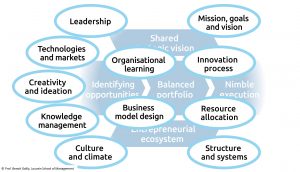
Bibliography
Megatrends: beyond hi-tech
Keywords: ageing, artificial intelligence, China, creative destruction, digitalization, disruption, environmental innovation, globalization, green innovation, industrial revolutions, internationalization, obsolescence, sustainability, technological change, trends, VUCA, waves of innovation, wealth creation.
- (Book) Brundtland, G., Khalid, M., Agnelli, S., Al-Athel, S., Chidzero, B., Fadika, L. & Singh, M. (1987). Our common future (“The Brundtland report”).
- (Book) Doz, Y. L., & Wilson, K. (2012). Managing global innovation: Frameworks for integrating capabilities around the world. Harvard Business Press.
- (Book) Freeman, C., 1974. The Economics of Industrial Innovation. Penguin, Harmondsworth.
- (Book) Hinssen, P., & Chellam, M. (2010). The New Normal: Explore the limits of the digital world. Mach media.
- (Book) King, S. (2017) Grave New World, Yale University Press
- (Book) Kuhn, T. S. (1970). The Structure of Scientific Revolutions, 2nd enl. ed. University of Chicago Press.
- (Book) Kuratko et al. (2011) Corporate Innovation and Entrepreneurship”, 3rd edition South-Western Cengage Learning
- (Book) Mokyr, J. (2002). The gifts of Athena: Historical origins of the knowledge economy. Princeton University Press.
- (Book) Nelson, R.R., Winter, S.G., 1982. An Evolutionary Theory of Economic Change. Harvard University Press, Massachusetts.
- (Book) Schumpeter, J. (1942) Creative destruction. Capitalism, socialism and democracy, 82-5.
- (Video) Demain (Ciril Lyon)
- (Video) An Inconvenient Truth (Davis Guggenheim)
- (Video) J. Raymond-Milet (1947) « La télévision, l’oeil de demain » inspired from René Barjavel : “Cinéma Total” (1944).
- (Video) Prof. John Bessant, University of Exeter (2020) on Managing Innovation
- (Article) Abernathy, W. J., & Clark, K. B. (1985). Innovation: Mapping the winds of creative destruction. Research Policy, 14(1), 3-22.
- (Article) Abramovitz, M. (1956). Resource and output trends in the United States since 1870. In Resource and output trends in the United States since 1870 (pp. 1-23). NBER.
- (Article) Acemoglu, D., Aghion, P., Bursztyn, L., & Hemous, D. (2012). The environment and directed technical change. American Economic Review, 102(1), 131-66.
- (Article) Aghion, P., & Howitt, P. (1990). A model of growth through creative destruction (No. w3223). NBER.
- (Article) Anderson, J., & Markides, C. (2007). Strategic innovation at the base of the pyramid. MIT Sloan Management Review, 49(1), 83.
- (Article) Awate, S., Larsen, M. M., & Mudambi, R. (2012). EMNE catch‐up strategies in the wind turbine industry: Is there a trade‐off between output and innovation capabilities?. Global Strategy Journal, 2(3), 205-223.
- (Article) Baumgartner, R. J., & Rauter, R. (2017). Strategic perspectives of corporate sustainability management to develop a sustainable organization. Journal of Cleaner Production, 140, 81-92.
- (Article) Brown, S. L., & Eisenhardt, K. M. (1997). The art of continuous change: Linking complexity theory and time-paced evolution in relentlessly shifting organizations. Administrative Science Quarterly, 1-34.
- (Article) Cheng, C., Yang, C., & Sheu, C. (2014).’The link between eco-innovation and business performance: a Taiwanese industry context’. Journal of Cleaner Production, 64, 81-90.
- (Article) D’Aveni, R.A., Dagnino, G.B., & Smith, K.G. (2010). The age of temporary advantage. Strategic Management Journal, 31(13), 1371-1385.
- (Article) Dew, N., Sarasvathy, S.D., Read, S., & Wiltbank, R. (2008). Immortal firms in mortal markets?: An entrepreneurial perspective on the “innovator’s dilemma”. European Journal of Innovation Management, 11(3), 313-329.
- (Article) George, G., McGahan, A. M., & Prabhu, J. (2012). Innovation for inclusive growth: Towards a theoretical framework and a research agenda. Journal of Management Studies, 49(4), 661-683
- (Article) George, G., Howard-Grenville, J., Joshi, A., & Tihanyi, L. (2016). Understanding and tackling societal grand challenges through management research. Academy of Management Journal, 59(6), 1880-1895.
- (Article) Hansen, E.; Große-Dunker, F. & Reichwald, R. (2009): Sustainability Innovation Cube – A Framework to Evaluate Sustainability-Oriented Innovations, International Journal of Innovation Management, 13(4), 683-713
- (Article) Hardin,G. (1968). The Tragedy of the Commons. Science, 162, 1243-1248.
- (Article) Hasan, I., & Tucci, C. L. (2010). The innovation–economic growth nexus: Global evidence. Research Policy, 39(10), 1264-1276.
- (Article) Horbach, J. (2008). Determinants of environmental innovation—New evidence from German panel data sources. Research Policy, 37(1), 163-173.
- (Article) Huebner, J. (2005). A possible declining trend for worldwide innovation. Technological Forecasting and Social Change, 72(8), 980-986.
- (Article) Jones, B. F. (2009). The burden of knowledge and the “death of the renaissance man”: Is innovation getting harder?. The Review of Economic Studies, 76(1), 283-317
- (Article) Jones, C. I. (1995). R & D-based models of economic growth. Journal of political Economy, 103(4), 759-784.
- (Article) Kremer, M. (1993). Population growth and technological change: One million BC to 1990. The Quarterly Journal of Economics, 108(3), 681-716.
- (Article) Lucas Jr, R. E. (1988). On the mechanics of economic development. Journal of Monetary Economics, 22(1), 3-42.
- (Article) Markides, C. C., & Anderson, J. (2006). Creativity is not enough: ICT-enabled strategic innovation. European Journal of Innovation Management, 9(2), 129-148.
- (Article) McCloskey, D. N. (2013). Tunzelmann, Schumpeter, and the hockey stick. Research Policy, 42(10), 1706-1715.
- (Article) Mokyr, J., Vickers, C., & Ziebarth, N. L. (2015). The history of technological anxiety and the future of economic growth: Is this time different?. Journal of Economic Perspectives, 29(3), 31-50.
- (Article) Moore, J. F. (1993). Predators and prey: a new ecology of competition. Harvard Business Review, 71(3), 75-86.
- (Article) Nidumolu, R., Prahalad, C.K., & Rangaswami, M.R. (2009). Why sustainability is now the key driver of innovation. Harvard Business Review, 87(9), 56-64.
- (Article) Rodrik, D (2000) “How Far Will International Economic Integration Go? Journal of Economic Perspectives 14(1), 177–186
- (Article) Romer, P. M. (1986). Increasing returns and long-run growth. Journal of Political Economy, 94(5), 1002-1037.
- (Article) Schiederig, T., Tietze, F., & Herstatt, C. (2012). Green innovation in technology and innovation management–an exploratory literature review. R&D Management, 42(2), 180-192.
- (Article) Seebode, D., Jeanrenaud, S., & Bessant, J. (2012). Managing innovation for sustainability. R&D Management, 42(3), 195-206.
- (Article) Smith, A., Voß, J. P., & Grin, J. (2010). Innovation studies and sustainability transitions: The allure of the multi-level perspective and its challenges. Research Policy, 39(4), 435-448.
- (Article) Smith, A., & Raven, R. (2012). What is protective space? Reconsidering niches in transitions to sustainability. Research Policy, 41(6), 1025-1036.
- (Article) Smith, A., Stirling, A., & Berkhout, F. (2005). The governance of sustainable socio-technical transitions. Research Policy, 34(10), 1491-1510.
- (Article) Solow, R.M. (1957). Technical Change and the Aggregate Production Function, The Review of Economics and Statistics, 39(3), 312-320.
- (Article) Sutter, C., Bruton, G. D., & Chen, J. (2019). Entrepreneurship as a solution to extreme poverty: A review and future research directions. Journal of Business Venturing. 34(1), 197-214
- (Article) Triguero, A., Moreno-Mondéjar, L., & Davia, M. (2013). ‘Drivers of different types of eco-innovation in European SMEs’. Ecological Economics, 92, 25-33.
- (Article) Wilson, K., & Doz, Y. L. (2011). Agile innovation: A footprint balancing distance and immersion. California Management Review, 53(2), 6-26.
- (Article) Yoo, Y., Boland Jr, R. J., Lyytinen, K., & Majchrzak, A. (2012). Organizing for innovation in the digitized world. Organization Science, 23(5), 1398-1408.
Industry and sector trends
Keywords: competitive environment, corporate foresight, customer needs, disruptive technologies, emerging technologies, industry evolutions, scenarios, stakehoders expectations.
- (Book) Goffin, K. & Mitchell, R. (2005) “Innovation Management” Palgrave Macmillan
- (Book) Diamond, J. (1998) Guns, Germs and Steel: A Short History of Everybody for the Last 13000 Years, London: Vintage
- (Book) Brynjolfsson, E., & McAfee, A. (2011). Race against the machine. Digital Frontier, Lexington, MA.
- (Book) Rohrbeck, R. (2010). Corporate foresight: towards a maturity model for the future orientation of a firm. Springer Science & Business Media.
- (Video) Danny Hillis: Back to the future (of 1994) (TED talk)
- (Video) The Five Competitive Forces That Shape Strategy – Harvard business Review
- (Article) Aghion, P., Bloom, N., Blundell, R., Griffith, R., & Howitt, P. (2005). Competition and innovation: An inverted-U relationship. The Quarterly Journal of Economics, 120(2), 701-728.
- (Article) Amore, M.D. (2015). Companies learning to innovate in recessions. Research Policy, 44(8), 1574-1583.
- (Article) Chattopadhyay, P., Glick, W. H., & Huber, G. P. (2001). Organizational actions in response to threats and opportunities. Academy of Management Journal, 44(5), 937-955.
- (Article) Ganter, A., & Hecker, A. (2013). Deciphering antecedents of organizational innovation. Journal of Business Research, 66(5), 575-584.
- (Article) Hecker, A., & Ganter, A. (2013). The influence of product market competition on technological and management innovation: firm‐level evidence from a large‐scale survey. European Management Review, 10(1), 17-33.
- (Article) Jackson, S. E., & Dutton, J. E. (1988). Discerning threats and opportunities. Administrative Science Quarterly, 370-387.
- (Article) Meyer, A. D., Brooks, G. R., & Goes, J. B. (1990). Environmental jolts and industry revolutions: Organizational responses to discontinuous change. Strategic Management Journal, 93-110.
- (Article) Meyer, A. D., Gaba, V., & Colwell, K. A. (2005). Organizing far from equilibrium: Nonlinear change in organizational fields. Organization Science, 16(5), 456-473.
- (Article) Mone, M., McKinley, W., & Barker, V. (1998). ‘Organizational decline and innovation: a contingency framework’. Academy of Management Review, 23, 115-132.
- (Article) Orsenigo, L., Pammolli, F., & Riccaboni, M. (2001). Technological change and network dynamics: lessons from the pharmaceutical industry. Research Policy, 30(3), 485-508.
- (Article) Probst, G., & Raisch, S. (2005). Organizational crisis: The logic of failure. Academy of Management Perspectives, 19(1), 90-105.
- (Article) Rohrbeck, R., & Gemünden, H. G. (2011). Corporate foresight: Its three roles in enhancing the innovation capacity of a firm. Technological Forecasting and Social Change, 78(2), 231-243.
- (Article) Ruff, F. (2006). Corporate foresight: integrating the future business environment into innovation and strategy. International Journal of Technology Management, 34(3-4), 278-295.
- (Article) Siggelkow, N., & Rivkin, J. W. (2005). Speed and search: Designing organizations for turbulence and complexity. Organization Science, 16(2), 101-122.
- (Article) Taalbi, J. (2017). What drives innovation? Evidence from economic history. Research Policy, 46(8), 1437-1453.
Innovation as a strategic priority
Keywords: growth, pioneer, sensemaking, strategic priority.
- (Book) Van de Ven, A.H. et al. (2008) The Innovation Journey, Oxford University Press
- (Book) Collins, J., & Hansen, M. T. (2011). Great by Choice: Uncertainty, Chaos and Luck-Why some thrive despite them all. Random House.
- (Book) Edquist, C., L. Hommen, and M. McKelvey (2001) Innovation and Employment, Process versus Product Innovation, Cheltenham: Elgar
- (Video) Joe Tidd Developing an innovation strategy (innovation masters)
- (Article) Berghman L., Matthyssens P., Streukens S., Vandenbempt K., (2013) Deliberate Learning Mechanisms for Stimulating Strategic Innovation Capacity, Long Range Planning, 46(1-2), 39-71
- (Article) Cefis, E., & Marsili, O. (2005). A matter of life and death: innovation and firm survival. Industrial and Corporate change, 14(6), 1167-1192.
- (Article) Forsman, H., & Temel, S. (2011). Innovation and business performance in small enterprises: An enterprise-level analysis. International Journal of Innovation Management, 15(03), 641-665.
- (Article) Hall, B. H., Lotti, F., & Mairesse, J. (2009). Innovation and productivity in SMEs: empirical evidence for Italy. Small Business Economics, 33(1), 13-33.
- (Article) Keupp, M.M., Palmié, M., & Gassmann, O. (2012). The strategic management of innovation: A systematic review and paths for future research. International Journal of Management Reviews, 14(4), 367-390.
- (Article) Maitlis, S., & Sonenshein, S. (2010). Sensemaking in crisis and change: Inspiration and insights from Weick (1988). Journal of Management Studies, 47(3), 551-580.
- (Article) Mansury, M. A., & Love, J. H. (2008). Innovation, productivity and growth in US business services: A firm-level analysis. Technovation, 28(1-2), 52-62.
- (Article) Theodosiou M., Kehagias J., Katsikea E., (2012) Strategic orientations, marketing capabilities and firm performance: An empirical investigation in the context of frontline managers in service organizations, Industrial Marketing Management, 41(7), 1058-1070
- (Article) Weick, K. E. (1988). Enacted sensemaking in crisis situations. Journal of Management Studies, 25(4), 305-317.
- (Article) Weick, K. E. (1993). The collapse of sensemaking in organizations: The Mann Gulch disaster. Administrative Science Quarterly, 628-652.
- (Article) Weick, K.E., Sutcliffe, K.M., & Obstfeld, D. (2005). Organizing and the process of sensemaking. Organization Science, 16(4), 409-421.
Developing innovation management capabilities
Keywords: dynamic capabilities, corporate entrepreneurship, strategic leadership
- (Book) Davila T., Epstein M.J. and Shelton R. (2006) Making innovation work. Wharton School Publishing,
- (Book) Helfat, C., Finkelstein, S., Mitchell, W., Peteraf, M., Singh, H., Teece and D., Winter, S. (2009). Dynamic capabilities: Understanding strategic change in organizations. John Wiley & Sons.
- (Book) McCullough, D. (2015). The Wright Brothers. Simon and Schuster.
- (Video) Why Do Large Companies Continue to Innovate? by Kuczmarski Innovation (on Vimeo)
- (Article) Ahuja, G., Lampert, C. M., & Tandon, V. (2008). Moving beyond Schumpeter: management research on the determinants of technological innovation. Academy of Management Annals, 2(1), 1-98.
- (Article) Ambrosini, V., & Bowman, C. (2009). What are dynamic capabilities and are they a useful construct in strategic management?. International Journal of Management Reviews, 11(1), 29-49.
- (Article) Aspara, J., Hietanen, J., & Tikkanen, H. (2010). Business model innovation vs replication: financial performance implications of strategic emphases. Journal of Strategic Marketing, 18(1), 39-56.
- (Article) Barreto, I. (2010). Dynamic capabilities: A review of past research and an agenda for the future. Journal of Management, 36(1), 256-280.
- (Article) Barringer, B. R., & Bluedorn, A. C. (1999). The relationship between corporate entrepreneurship and strategic management. Strategic Management Journal, 20(5), 421-444.
- (Article) Boly, V., Morel, L. & Camargo, M. (2014). Evaluating innovative processes in French firms: Methodological proposition for firm innovation capacity evaluation. Research Policy, 43(3), 608-622.
- (Article) Brown, S. L., & Eisenhardt, K. M. (1997). The art of continuous change: Linking complexity theory and time-paced evolution in relentlessly shifting organizations. Administrative Science Quarterly, 1-34.
- (Article) Chatzoglou, P., & Chatzoudes, D. (2017). The role of innovation in building competitive advantages: an empirical investigation. European Journal of Innovation Management
- (Article) Chiesa, V., Coughlan, P., & Voss, C. A. (1996). Development of a technical innovation audit. Journal of Product Innovation Management, 13(2), 105-136.
- (Article) Collis, D. J., Anand, B. N., & Field, S. (2021). The virtues and limitations of dynamic capabilities. Strategic Management Review, 2(1), 47-78.
- (Article) Corbett, A., Covin, J. G., O’Connor, G. C., & Tucci, C. L. (2013). Corporate entrepreneurship: State‐of‐the‐art research and a future research agenda. Journal of Product Innovation Management, 30(5), 812-820.
- (Article) Corbett, A. (2018). The myth of the intrapreneur. Harvard Business Review, 26(06), 2018.
- (Article) Cormican, K., & O’Sullivan, D. (2004). Auditing best practice for effective product innovation management. Technovation, 24(10), 819-829.
- (Article) Covin, J. G., & Slevin, D. P. (1991). A conceptual model of entrepreneurship as firm behavior. Entrepreneurship Theory and Practice, 16(1), 7-26.
- (Article) Crossan, M.M. & Apaydin, M. (2010). A Multi-Dimensional Framework of Organizational Innovation: A systematic review of the Literature. Journal of Management Studies, 47(6), 1154-1191.
- (Article) Di Stefano, G., Peteraf, M., & Verona, G. (2010). Dynamic capabilities deconstructed: a bibliographic investigation into the origins, development, and future directions of the research domain. Industrial and Corporate Change, 19(4), 1187-1204.
- (Article) Eisenhardt, K., & Martin, J. (2000). Dynamic capabilities: What are they?. Strategic Management Journal, 21, 1105-1121.
- (Article) Fagerberg, J., Fosaas, M., & Sapprasert, K. (2012). Innovation: Exploring the knowledge base. Research Policy, 41(7), 1132-1153.
- (Article) Glinyanova, M., Bouncken, R. B., Tiberius, V., & Ballester, A. C. C. (2021). Five decades of corporate entrepreneurship research: measuring and mapping the field. International Entrepreneurship and Management Journal, 1-27.
- (Article) Hansen, M. T., & Birkinshaw, J. (2007). The innovation value chain. Harvard Business Review, 85(6), 121.
- (Article) Hidalgo, A., & Albors, J. (2008). Innovation management techniques and tools: a review from theory and practice. R&D Management, 38(2), 113-127.
- (Article) Hornsby, J.S., Kuratko, D.F., Holt, D.T., & Wales, W.J. (2013). Assessing a measurement of organizational preparedness for corporate entrepreneurship. Journal of Product Innovation Management, 30(5), 937-955.
- (Article) Ireland, R. D., & Hitt, M. A. (1999). Achieving and maintaining strategic competitiveness in the 21st century: The role of strategic leadership. Academy of Management Perspectives, 13(1), 43-57.
- (Article) Kuratko, D. F., & Audretsch, D. B. (2013). Clarifying the domains of corporate entrepreneurship. International Entrepreneurship and Management Journal, 9(3), 323-335.
- (Article) Kyrgidou, L. P., & Spyropoulou, S. (2013). Drivers and performance outcomes of innovativeness: an empirical study. British Journal of Management, 24(3), 281-298.
- (Article) Lawson B. & Samson D. (2000). Developing Innovation Capability in Organization. International Journal of Innovation Management 5(3), 377-400.
- (Article) Meyer, A. D. (1982). Adapting to environmental jolts. Administrative Science Quarterly, 515-537.
- (Article) Mezger, F. (2014). Toward a capability‐based conceptualization of business model innovation: insights from an explorative study. R&D Management, 44(5), 429-449.
- (Article) Mintzberg, H. (1973). Strategy-making in three modes. California Management Review, 16(2), 44-53.
- (Article) Newbert, S. L. (2007). Empirical research on the resource‐based view of the firm: an assessment and suggestions for future research. Strategic Management Journal, 28(2), 121-146.
- (Article) O’Connor, G. C. (2008). Major innovation as a dynamic capability: A systems approach. Journal of Product Innovation Management, 25(4), 313-330.
- (Article) O’Regan, N., Ghobadian, A., & Sims, M. (2006). Fast tracking innovation in manufacturing SMEs. Technovation, 26(2), 251-261.
- (Article) Peteraf, M., Di Stefano, G., & Verona, G. (2013). The elephant in the room of dynamic capabilities: Bringing two diverging conversations together. Strategic Management Journal, 34(12), 1389-1410.
- (Article) Phan, P. H., Wright, M., Ucbasaran, D., & Tan, W. L. (2009). Corporate entrepreneurship: Current research and future directions. Journal of Business Venturing, 24(3), 197-205.
- (Article) Romijn, H., & Albaladejo, M. (2002). ‘Determinants of innovation capability in small electronics and software firms in southeast England’. Research Policy, 31, 1053-1067.
- (Article) Rothaermel, F., & Hess, A. (2007). Building Dynamic Capabilities: Innovation Driven by Individual-, Firm-, an Network-Level Effects. Organization Science, 18, 898-921.
- (Article) Samson, D., Gloet, M., & Prakash S. (2017). Systematic Innovation Capability; evidence from case studies and a large survey. International Journal of Innovation Management, 1750058.
- (Article) Siguaw, J. A., Simpson, P. M., & Enz, C. A. (2006). Conceptualizing innovation orientation: A framework for study and integration of innovation research. Journal of Product Innovation Management, 23(6), 556-574.
- (Article) Smith, M., Busi, M., Ball, P., & Van der Meer, R. (2008). Factors influencing an organisation’s ability to manage innovation: a structured literature review and conceptual model. International Journal of Innovation Management, 12(4), 655-676.
- (Article) Teece, D.J. (2007). Explicating dynamic capabilities: the nature and microfoundations of (sustainable) enterprise performance. Strategic Management Journal, 28(13), 1319-1350.
- (Article) Teece, D.J., Pisano, G., & Shuen, A. (1997). Dynamic capabilities and strategic management. Strategic Management Journal, 509-533.
- (Article) Terziovski, M. (2010). ‘Innovation practice and its performance implications in small and medium entreprises (SMEs) in the manufacturing sector: A resource-based view’. Strategic Management Journal, 31, 892-902.
- (Article) Tidd, J., & Bessant, J. (2018). Innovation management challenges: from fads to fundamentals. International Journal of Innovation Management, 1840007.
- (Article) Van der Panne, G., Van Beers, C., & Kleinknecht, A. (2003). Success and failure of innovation: a literature review. International Journal of Innovation Management, 7(03), 309-338
- (Article) Verona, G. (1999). A resource-based view of product development. Academy of Management Review, 24(1), 132-142.
- (Article) Wang, C. L., & Ahmed, P. K. (2007). Dynamic capabilities: A review and research agenda. International Journal of Management Reviews, 9(1), 31-51.
(c) Prof. Benoit Gailly, Louvain School of Management
